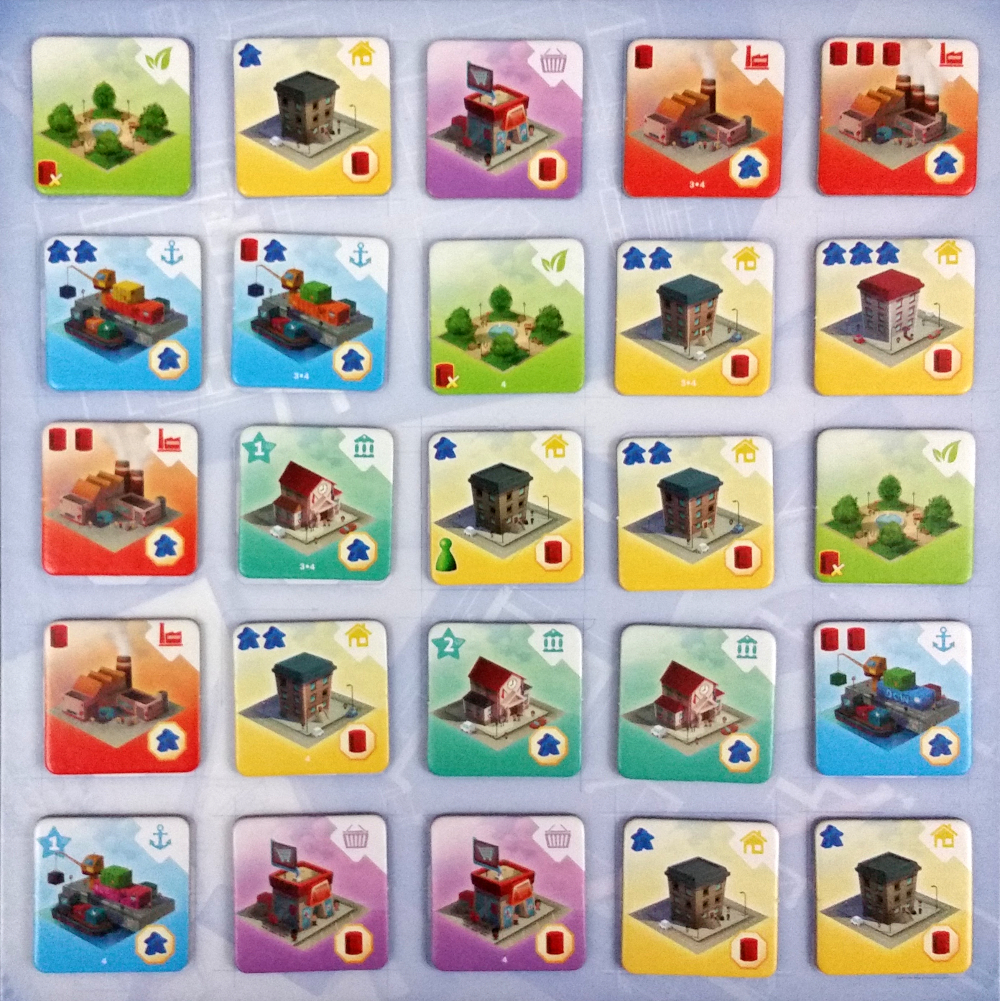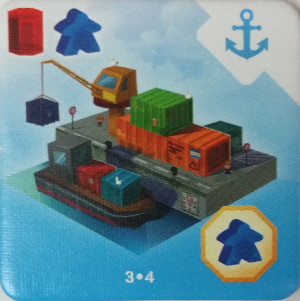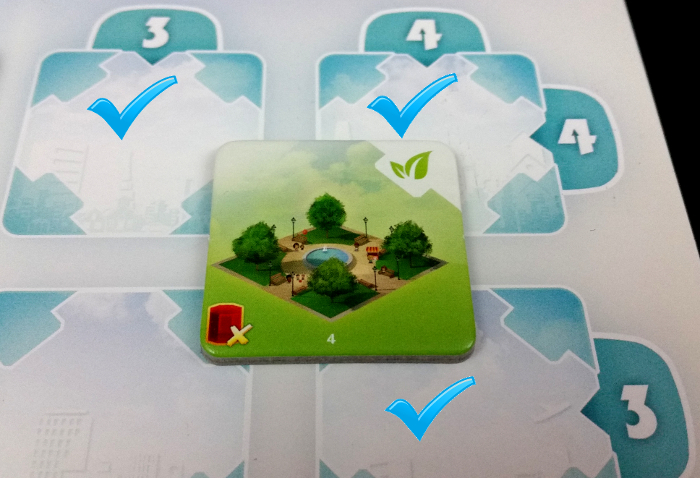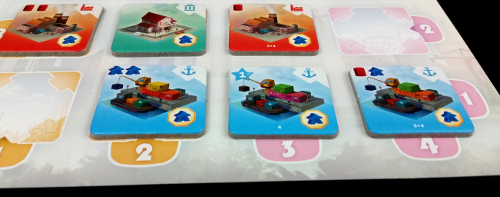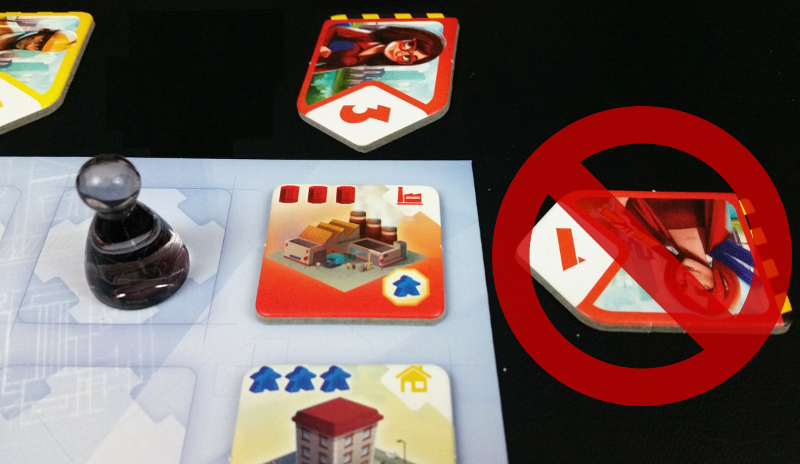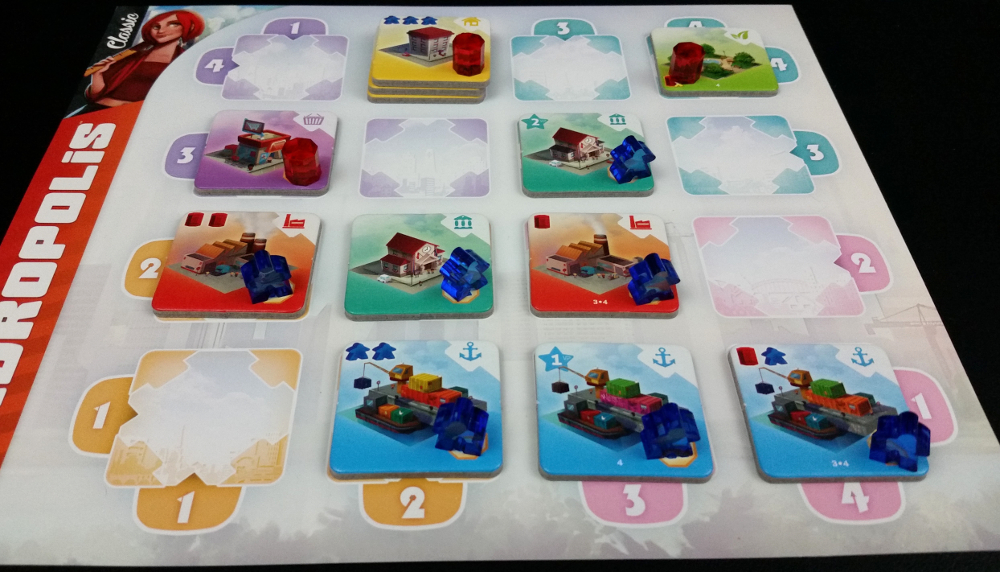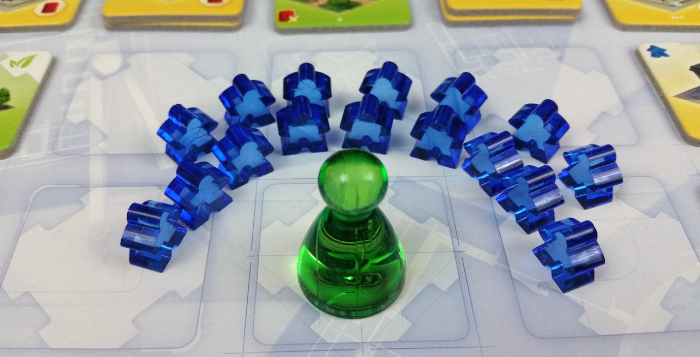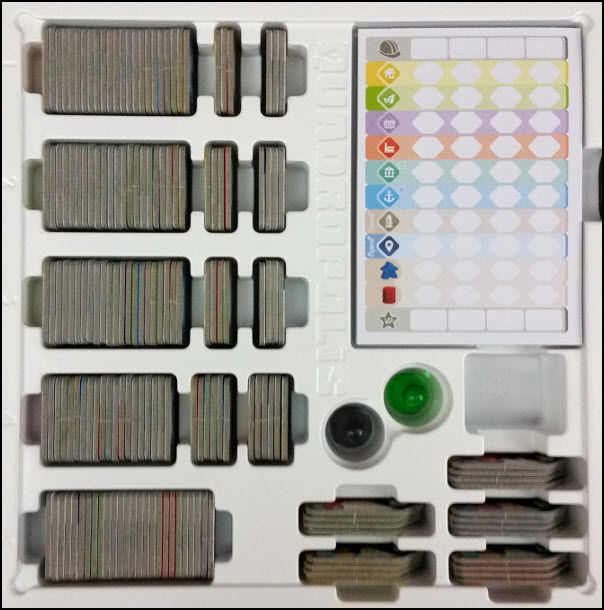The radio crackled to life at Quint’s Urban Area Development, interrupting the quiet but fleeting retreat of the facility’s break room. Central’s voice sputtered through. “Architect Four, pick up a municipal structure from C3 for placement in Row 3, next to the park.”
The architect sighed, rubbed a hand across his chiseled chin, and pressed his hard hat back onto his head. He knew this break was too good to last. He glanced at the plain wall clock hanging overhead and stood to make his way back to the factory floor. It ticked 12:16 – exactly four minutes since he sat down.
Right on schedule.
The Premise
Quadropolis is a city-building tile game based around the number four. As city planners seeking to create the best district, players oversee four architects that they use to pull tiles from a central board and place strategically in their own territory.
The Rules
As a lightweight tile-placement game, setup for Quadropolis is fairly quick, though it does require modest table space for the player boards, central board, tile stacks, and the game’s two resource types – Inhabitants and Energy.
To begin, each player is given a set of Architects, numbered 1-4, and a player board. Each player board consists of a 4×4 grid that is segmented into four colored sections. The first player is determined randomly.
Quadropolis takes place over a series of four rounds, in which each player will have (wait for it) four turns. At the beginning of each round, the central board is randomly populated by placing tiles face-down matching the round number. Then a number of those tiles are revealed, depending on the player size.
On a player’s turn they first select one of their Architects and place it on a spot adjacent to the central board so that it lines up with one of its rows or columns. The only restrictions are that it can’t be placed on a spot already with an Architect and the row or column it faces cannot contain the Urbanist marker.
The player then takes the tile on the space corresponding to that Architect’s number. (For example, if the player sets down Architect Two, they take the second tile in from the edge.) Next, the Urbanist moves to the newly emptied space. Finally, they place the tile on their board on an available space either in the row or column that similarly corresponds to Architect’s number. Then it becomes the next player’s turn.
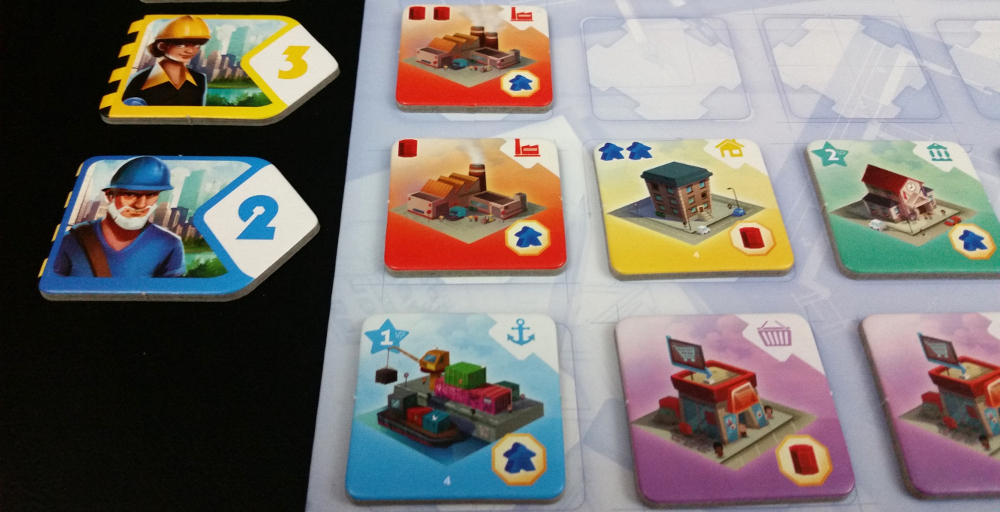
Placing Architect 2, Blue takes the 2nd tile in that row (the Apartment) and places it on their board in the 2nd row, column, or (in the case of Apartments) floor number
Most tiles in the game either provide Inhabitant meeples or Energy units when placed. Every tile is capable of providing VP at the end of the game, though many tiles require Inhabitants or Energy on them in order to be scored. However, players can move these resources around freely until the very end of the game.
After each player has placed all four Architects, the round ends. Everyone retrieves their Architects; any remaining tiles on the central board are removed. Then a new round begins. If someone took the tile with the First Player marker, they begin the new round; otherwise turn order doesn’t change.
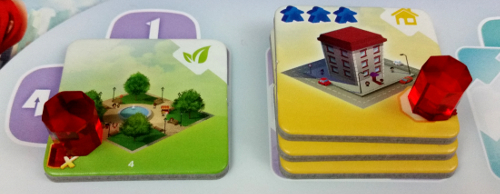
The Park scores 2 points for adjacency to the Tower. The (activated) Tower scores 6 points based on a floor size of three.
After four rounds, the game ends and players score their cities. Each of the game’s six tile types scores points based on different criteria. (Apartments, for example, score points based on their number of floors.) The player with the most VP wins, having demonstrated their excellent mayoral skills in creating the most appealing city.
Everyone else may want to think about hiring different contractors next time.
Planning Four The Future
Many of the best games feature a mechanism so unique and simple that it’s hard to believe it hasn’t been seen before. The tile selection and placement mechanic in Quadropolis is one such example. Quadropolis hangs its entire existence on the number four: the game has four rounds with four turns, each with four steps. The player boards have four rows, columns, and regions. Each tile has four different point values. Even the name itself means ‘four cities’.
And it works.
From the onset, the game manages to make an enjoyable experience out of restricting how you choose a single tile each turn. Built on a good foundation, Quadropolis effortlessly creates a presentation of both form and function, all while simultaneously supporting the game’s underlying premise. Simply put, it’s elegant.
Part of this is because Quadropolis is remarkably easy to explain and understand, but it still allows for a fair amount of strategy. On the surface, it’s simple to comprehend that you only have four turns per round and that where you put your tile is dependent on the Architect number you use.
What’s more, because the assortment of tiles changes so much from one round to the next – let alone between playthroughs – the game presents a considerable amount of variation to the arrangement of tiles for you to navigate. The challenge comes from puzzling out how to acquire the tile you want for the space you want more than dealing with a complex rule system or complicated board, which helps make the game accessible to a wide spectrum of players.
This ease of understanding translates into the strategic side of the game as well. Quadropolis is relatively forgiving if you have to change your tactics midgame, for instance. As a result, even though it’s essentially a light tile placement game, Daredevils should find it favorable due to the freedom to express some avant garde city planning.
That said, because there are only six tile types, the number of strategies are finite. For the most part the game allows you to experiment with different decisions, because any tile is capable of scoring you points. As such, it’s not uncommon to favor repeating the same handful of grand strategies from one game to the next, even though the tactics involved will fluctuate. In the end there really isn’t a strategy that does remarkably better than any other in Quadropolis, nor one that does remarkably worse. In this game you are rewarded equally for diversifying your selections or making deep dives to max out the points scored from one tile type. Investing heavily in Factories, for example, can yield a lot of points but also requires extensive planning.
What does matter, however, is turn order. The earlier your turn, the more options you have at your disposal. Going last repeatedly in multiple rounds can be detrimental to your score, so jockeying for first player usually becomes a mini strategy unto itself.
Above all, the game rewards considered moves over randomly grabbing tiles. This ensures that even though the available strategies in the game aren’t incredibly deep, they do require thoughtful and meaningful choices. Therefore, even though it’s on the lighter end of strategic complexity, this is one lightweight game Tacticians can get behind.
Yet the logic-based placement process in Quadropolis is not universally ideal. For one, there is a slight learning curve with new players. For another, players can occasionally find themselves in a tricky situation if they fill one area of their board too quickly, making it so that there’s no valid spot to place a tile. In those situations, the tile is forfeit and is essentially a wasted turn. Scores in the game are generally tight, so even one missed opportunity can cost a player a few key points.
That being the case, it’s rather surprising that Architects will be decidedly mixed on this game given their civ-building nature. While they will definitely enjoy placing the tiles and attempting to build the best city, they will also often feel stymied by the inability to simply build as they please. In reality, Quadropolis is less a city-building game than it is a tile game with a creative placement approach.
Welcome To Quintopolis
So much – perhaps too much – of the game’s identity is wrapped up this “Idea of Four. The one real downside to Quadropolis is that despite its interesting central mechanic, the game itself presents a lot of style without a lot of substance.
On the one hand, it provides some interesting decision-making moments and does an admirable job keeping the game entertaining even with the various restrictions it imposes. On the other hand, you are faced with a declining number of choices to make each turn as the game progresses, with one option almost always more ideal than the rest.
In a sense, the game at times gets tripped up by its own cleverness.
This is alleviated to an extent by the addition of a “hard” mode for more experienced players, but playing in Expert mode also undermines the use of the game’s central conceit – that every choice be based around the number four. Instead, Expert mode challenges players with additional buildings, a fifth round, and has you place five Architects from a now-combined pool of them across the five zones on your board. While this does increase the complexity and provides new pathways to explore, it does so at the cost of the game’s core theme.
For Immersionists, it likely won’t matter either way. There’s already not much by way of narrative for them to sink their teeth into with this game, so you can expect them to opt for other cityscapes, regardless which mode is used.
None of this explicitly means that Quadropolis has poor replay value – far from it. Rather, it’s more a case of it not having as high of a level of replayability as you’d expect based on initial impression.
A Picturesque Cityscape
What is undisputed, however, is the game’s top-notch physical quality. The most notable part of the game – even more than its premise – is its components. Days of Wonder is known for putting out high-quality games that leave a lasting mark. The same is true here. The materials to Quadropolis are top-notch with durable tiles, high quality plastic resources, distinctive but simple artwork, and an overall inviting appearance. Even the game’s insert is impressive, not only perfectly housing the contents of the game but going so far as to incorporate leftover cardboard sprues into its storage solution.
However, as inviting as the game is with its bright visuals and easy ruleset, there is very little in-game interaction between players during its 45-minute runtime. Because of this, as light as it is, Quadropolis isn’t going to appeal to most Socializers since most of your efforts are focused on your individual city. Some may still find it worthwhile thanks to the game’s casual nature, giving you time to converse with other players, but for many that won’t be enough.
For these same reasons, it’s not likely to be a favorite of Strikers due to the inability to affect your opponents in any meaningful way. While the game definitely has the capacity for you to steal a tile that another player wants, your selection more often comes down to it being an optimal tile choice for you more than it being an object of desire for another player. In this game you’re always better off taking a piece that benefits you more than hurts someone else, even if you sometimes bump into each other along the way.
The Takeaway
Quadropolis is a good, solid game with superb production value and a mechanic that’s as inventive as it is clever. The idea of basing everything around the number four may be somewhat gimmicky, but it works, as those creative restrictions are what fuels the game’s modest challenges. Yet it also leans heavily on that hook. Quadropolis forces you to balance spatial reasoning and planning ahead against a logic puzzle of trying to maximize your tile values, all while the number of possible moves keeps shrinking. More impressively, it does this while keeping itself accessible to both casual and strategy gamer alike, making it a lightweight game with some staying power. There are limits to its appeal, however, as even with the addition of its advanced gameplay version, it lacks the depth of variable strategy or thematic resonance to be considered a true classic.
Quadropolis is a product of Days of Wonder.
Cardboard Republic Snapshot Scoring (Based on scale of 5):
Artwork: 4
Rules Clarity: 5
Replay Value: 3
Physical Quality: 5
Overall Score: 3.5

